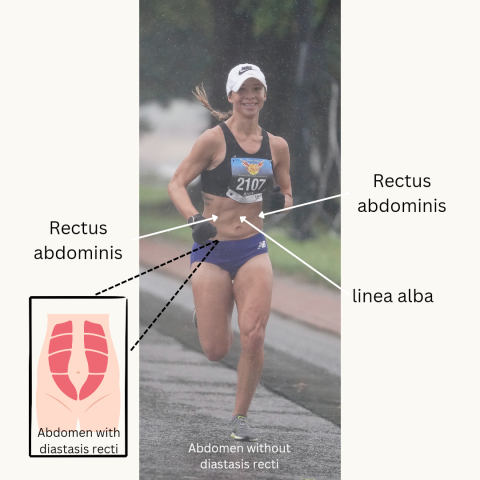What is Coning or Doming?
Coning or Doming refers to bulging that occurs in the core when performing strenuous exercise. Medically, coning or doming is associated with diastasis recti abdominal (DRA). Coning or doming is understood to be the mismanagement of intra-abdominal pressure during a core contraction due to poor breathing and/or poor core muscle recruitment. Abdominal separation of greater than 2 cm is considered the gold standard for diagnosing DRA. However, DRA is not one dimensional, but multidimensional to include the width of separation, depth of separated tissue, tissue integrity (is it squishy or does it have a bounce to it), and the person’s ability to engage the core and reduce DRA actively with minimal to no coning or doming.
Oftentimes, coning or doming is seen in pregnant and postpartum women as DRA occurs as the linea alba (the fibrous tissue going down the middle of the abdomen that connects both sides of the core) is stretched to accommodate the growing baby. Postpartum coning and doming is very common as women return to everyday life including walking and picking up baby, but will often be noticed with a return to lifting and exercising. DRA associated with postpartum women will often get better, but if not corrected early, coning and doming may still persist similar to untreated urinary leaking postpartum. The pelvic floor will recover from being overstretched, but if not addressed early, leaking may still occur when stressed.
Previous to having children, I never gave postpartum coning or doming much thought. I had been aware of it, but it seemed common enough that I had assumed it was a normal phenomenon because even before having kids I had noticed coning or doming on myself with various exercises. It never hurt so I never investigated it further.

However, after two pregnancies, being a physical therapist with additional education in pregnancy, postpartum, and return to fitness, I have routinely come across common misconceptions concerning pregnancy and postpartum specifically postpartum coning and doming that I would like to address by playing a little game called Myth or Fact.
Myth or Fact:
Coning or Doming ONLY occurs in females
MYTH
DRA and the associated coning or doming do NOT only occur in females. According to Kaufmann (2022), the prevalence of DRA for the general population is 57% with gender not being a risk factor meaning men and women did not have a statistically significant difference in occurrence. Statistically significant risk factors included age, obesity, and parity (defined according to the NHS Wales Data Dictionary as the number of times a woman has given birth or been pregnant at 24 weeks or more). However, the paper does call for a need to more clearly define DRA as the most commonly used tools for diagnosis include finger width and is therefore unreliable as each person’s finger width is different.
Myth or Fact:
DRA can be corrected conservatively or surgically

FACT
An abdominoplasty or a “tummy tuck” can be performed to surgically reduce abdominal separation. The majority of the time a tummy tuck is not covered by insurance as it is deemed a cosmetic and elective surgery. It should also be noted that a tummy tuck is still considered a major abdominal surgery that requires a recovery reflective of the surgery. It will take time and effort to heal.
However, if cosmetics are not a concern, conservative care such as physical therapy can be utilized to improve the effectiveness and efficiency of the core when dealing with DRA. Physical therapy will evaluate and assist a patient in laying the correct foundations to include improved breathing patterns and improved core recruitment leading to improved intra-abdominal pressure management resulting in reduced coming or doming when performing various activities.
Myth or Fact:
Postpartum Coning or Doming means I’m not ready to return to lifting
rovMYTH, MYTH, MYTH
I am going to begin this section with a little story from this past week at work. I work in a very busy outpatient clinic that likes to have a lot of fun where everyone is often found treating out in the gym. I was working with one patient while talking to another provider’s patient. I was giving the patient kudos as her back squats had improved dramatically along with improved posture at the depth of her squat. I then shared with her that one of my goals for her was to perform a 100# back squat. Her response was something sassy about how there’s no way she could do that, but I laughed it off and said something to the effect of, ”Let’s see what happens over the next few weeks.” The PTA that was working with the patient I was encouraging then chimed in by saying,
“Strong is the only way out.”
At that moment, I thought to myself, “ YES, that is everything. No truer words had been spoken. This is the principle my PT career sits upon. Strong is the only way out.”
The same principle applies to coning and doming, especially postpartum coning and doming.
Coning and doming is not something to be afraid of. It is simply a signal from your body saying one of three things:
- Your breathing sucks, fix it, and try again.
- Your core recruitment sucks, fix it, and try again.
- You did the above things correctly, but the resistance or exercise is simply too much.
If the third reason is true, modify the exercise and try again until you find the sweet spot that minimizes the amount of coning and doming and build yourself up to be able to accomplish the original exercise with minimal to no coning or doming.
Specifically, to the postpartum coning or doming mothers, do not be afraid of it. In most cases, it does not hurt, and I have not been able to find a single research article stating that coning or doming is harmful or a precursor for hernia. It is safe, but the coning or doming is a signal and we should listen to the signal by adjusting or modifying to reduce the stress on the core. If you are unable to figure out how to correctly improve your breathing, improve your core recruitment, or modify your exercise accordingly, I highly recommend finding a local physical therapist to assist you.
So to all my postpartum coning or doming mommas GET AFTER IT because strong is the only way out. Lift heavy shit, run, and live your life, but do it while respecting your body meaning listening to those signals.
I say all of this to come to the conclusion that for far too long, our society has been afraid of women’s bodies thinking they are fragile, especially postpartum bodies. However, the opposite is true. A woman’s body especially after birthing a small human is so badass and so freaking strong. I wish I could scream it from the top of a mountain and make sense to people but goodness, our bodies, as women, are so strong!

And for the troll who thinks this is not true – read Katherine Switzer’s story. Our society did not think women could run the marathon because they were fragile and somehow they believed a woman’s uterus might fall out. Switzer was the first woman to officially run the Boston Marathon in 1967. Race officials tried to physically remove her from the course during the race. It is such an inspiring story, yet it only happened 56 years ago. We have come a long way since then and now many women run marathons and compete in weightlifting and CrossFit. Just remember strong is the only way out.
Are you Coning or Doming?
If you are unable to figure out how to correctly improve your breathing, improve your core recruitment, or modify your exercise to reduce the coning or doming, I highly recommend finding a local physical therapist to assist you.
References:
Kaufmann, R.L., Reiner, C.S., Dietz, U.A. et al. Normal width of the linea alba, prevalence, and risk factors for diastasis recti abdominis in adults, a cross-sectional study. Hernia 26, 609–618 (2022). https://doi.org/10.1007/s10029-021-02493-7
Institue of Clinical Excellence. 2023. Clinical Managment of the Fitness Athlete: Pregnancy and Postpartum. Online. https://ptonice.com/courses-events/fitness-athlete-pregnancy-pp/

